Heart Compression Resuscitation LLC
A New Standard for "Feel'n Real" CPR Training Manikins
Competitive Analysis
Below is a chart, which compares Charlie’s features to those of the primary competitive manikins in the marketplace.
“Anne”, manufactured by Laerdal, has had a significant marketplace presence for years and holds an estimated market share believed to be as large as 60-70%. Laerdal is a privately owned company headquartered in Norway with offices in 23 countries, approximately $300 million in revenues, and 1,700 employees. Laerdal also produces a wide variety of other products for the health market in addition to much more expensive CPR feedback and training measurement devices ranging in price up to $9,000 each.
“Pal” is manufactured by Ambu, which is a publicly owned company headquartered in Denmark. Ambu generates approximately $190 million revenue per year and focuses primarily on providing very sophisticated devices for hospital care and training.
“Prestan”, which is a newer manikin in the marketplace, is manufactured in the U.S. by a small privately owned company.
Simulaids, the manufacturer of “Brad”, is a well-established privately owned company headquartered in New York. Research indicates that Simulaids generates annual revenue $7.5 million and has up to 200 employees, but this data may not be complete. Simulaids is a developer and manufacturer of training aids for emergency, medical, and rescue personnel.
The “D-Fib” manikin is produced by Armstrong Medical Industries Inc, which is a privately owned company headquartered in Lincolnshire, Illinois. Armstrong is also a distributor of manikins manufactured by other companies.
It has been difficult to locate financial or product sales information for the privately owned companies
* CPR MANIKIN COMPETITIVE ANALYSIS 6 = Very Good 1 = Poor 0 = Nonexistent
Competitive Features HCR Charlie Laerdal Anne* Prestan Simulaids (Brad) Armstrong (D-Fib) Ambu (Pal)
Compression Rate Guidance (1)
Compression Depth Feedback (2)
Rib Cracking Feel and Sounds (2)
Damping of Chest Rebound
Head Tilt, Jaw Thrust (3)
Anatomical Landmarks
Additional Data
Years in Warranty Period
Max Compression Depth (in.) (4)
Lbs of Thrust to Achieve Depth (5)
MSRP ($)
Basic - Advanced
(1) HCR's "Staying Alive" soundtrack supports the AHA guidelines of 100 compressions per minute
while also facilitating natural recall and longer lasting muscle memory
(2) HCR's simulated rib cracking and audible clicker support AHA guidelines of a depth of at least
2 inches while also setting up stronger future recall of the proper psychomotor skills
(3) Such features are no longer central to current AHA guidelines, which now call for giving
priority to chest compressions versus airway and ventilation/ breathing issues
(4) The AHA guidelines call for at least 2 inches in compression depth (measurements are + or - 0.2")
(5) The AHA suggests 100-120 lbs of thrust in order to achieve the required depth (the above are estimates)
*Laerdal offers computer monitoring options on other manikins, however, "Anne" is much
less costly and is currently the most frequently used CPR manikin in the marketplace
(with an estimated 60-70% market share)
6
6
6
0 - 6
2
6
3
2.2
100
239 - 289
1
2
0
0
5
4
1
229
4
4
0
0
6
6
3
125
1
1
0
2
2
5
3
200
3
1
0
0
5
3
1
100
1
1
0
0
5
5
1
250
 | ||||||
*Aside from items obviously not present in some manikins; number weighted values given to attributes were derived from our own observations and non-biased surveys of knowledgeable, independent sources. The results were then averaged in the interest of fairness. Physical measurement and force tests were performed using our in house laboratory facilities on competitive products retailing at the time. We used devices generally standard to the industry. While meant to be objective tests, these results were not certified by an independent laboratory. These results are of-course minimally subjective.
Testings results being compiled and posted when complete
